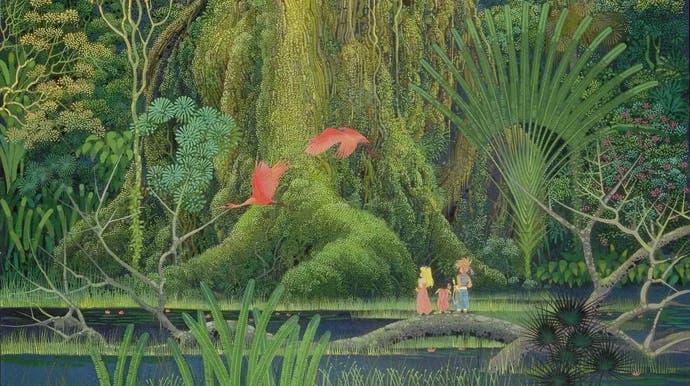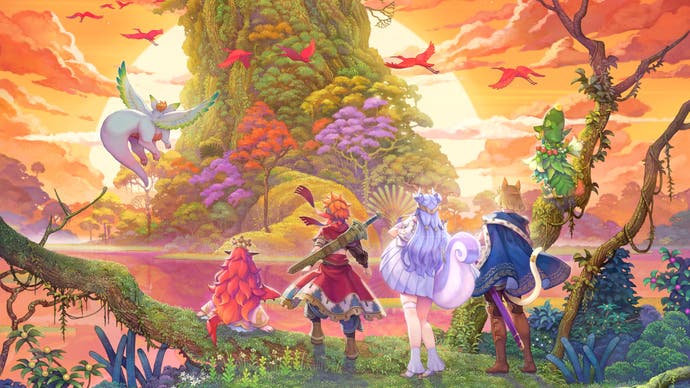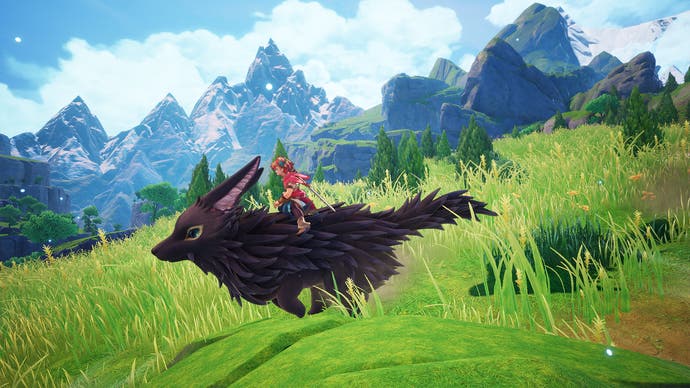Visions of Mana returns to series roots, but is yet to flower into a truly original experience
A new leaf.
I have quite distinct memories of SNES classic Secret of Mana, despite not playing it too much. It's the visuals that stick in my mind: the bright greens of its forest environments, the electric yellows and pinks of its cute plant and bug enemies, and of course the colossal tree and its tangled roots seen in the game's iconic box artwork.
All of this came flooding back to me as I played a demo of Visions of Mana, the next game in the long-running series. Its key artwork alone is a callback to the original, its heroes looking out at another giant tree as the sun sets behind, bathing its autumnal growths in a warm light. And that's before you step into the game's open world.
It turns out, this artistic callback is deliberate. "The key art [of Secret of Mana], or the package art, was illustrated by an artist named Hirō Isono," series producer Masura Oyamada told me. "And so, [in Visions of Mana] we really wanted to be able to create a field design that captures the mana tree that was depicted in the artwork. With the advances made in modern platforms, being able to adhere to these key components still helps retain that feeling of this being a Mana game even as everything is getting modernised."
It's clear, then, that Visions of Mana is something of a reset for the series. Various remasters and remakes of older games have been released in recent years, culminating in 2020's Trials of Mana. Visions of Mana, though, is the first brand new game in the series for over 15 years that both harkens back to the past and modernises for new systems.
To take you back, the Mana series began life as an action-RPG spin-off of Final Fantasy. The first was Seiken Densetsu (1991) for the Game Boy, known as Final Fantasy Adventure in North America and Mystic Quest in Europe. It was Secret of Mana (1993), though, that truly began the Mana name, which was soon followed by Trials of Mana (1995) on SNES and Legend of Mana (1999) on PS1. These games form the core of the series, though various new games and remakes have been released since; 2007's Heroes of Mana was the last mainline entry.


So why is the series returning now? While a new game was already being considered, the success of the various remakes helped convince Square Enix, as did a survey conducted by the publisher showing players of 2020's Trials of Mana "express strong interest" in a new title.
"When I took over as the series producer in 2014, it was actually already seven years since the previous mainline instalment had launched," said Oyamada. "It had reached a point where a lot of the classic Mana games were no longer playable with the hardware available. On my end, I really wanted to make sure I actually focus on remasters and remakes for the series so people can remember and think back about the series too.
"Through creating all these various remakes, we had already been thinking a little bit and exploring the idea of a new instalment, but with the release of Trials of Mana in 2020, seeing how the game was really received well by fans, that became a defining moment when we decided it was the right time to be able to create a new release."
It's certainly interesting that Final Fantasy has become more action-oriented in recent years, perhaps pushing the Mana series aside. The latter's return now brings a pleasing retro vibe away from flashy extravagance, though its modernisations may not be enough to entice new players.
I played two sections from Visions of Mana: a vast open meadow area called Fallow Steppe, and a more linear Mt. Gala area that led towards a boss. Throughout both I was able to switch between three characters in the party: lead character and swordmaster Val, whose fluffy brown hair and pink attire is reminiscent of the unnamed protagonist in Secret of Mana; wind-wielder Careena who's accompanied by baby flying beast Ramcoh; and surly cat boy Morley. The open area also let me ride pikul: scruffy terrier-like creatures used as mounts.
.png?width=690&quality=75&format=jpg&auto=webp)

And mounts are needed in the open world. It's vast and gorgeous: lush, verdant grassy hills and forests, spotted with the same vibrantly-coloured plants I remember from the pixel games of yore. Together with the orchestrated score and tin whistle melodies, the world has an idyllic bucolic charm expanded into 3D. Indeed, presentation is where the game excels, complete with its intricate character designs.
"The game has the largest, most expansive field within the series to date, and so being able to bring that to life, as well as the monster designs of the series' original creator Koichi Ishii, [which are] lovable, unique and charming, is definitely part [of modernisation]," said Oyamada. "Also taking the character designs of HACCAN and his unique, distinct art style and character design too, these are also major parts of the visual identity of the game."
The open world contains plenty to do besides gawping, be it battling familiar-looking critters, finding treasure chests, or completing simple side-quests. The more linear mountain area also introduced some light platforming and puzzling, using Elemental Vessels. Elemental powers are a staple of the Mana series alongside its monster designs, Oyamada said. Here, Elemental Vessels are an extension of elemental spirits to allow players to gently impact the environment. For instance, the gale boomerang can be used at set points to summon wind updrafts that can either raise platforms for new pathways, or be jumped into directly to fly upwards to new areas. It's all a bit mechanical without true freedom, but it at least shakes up exploration a little.
"Being able to capture the feeling of those spirits living within this world was important for us," said Oyamada of the Elemental Vessels. "As you go on this adventure, we wanted to design the game so that you could really feel the life of these spirits coursing through this world... and we made sure that is also implemented within the game system itself."
.png?width=690&quality=75&format=jpg&auto=webp)
Elemental powers also impact combat, the real core of the game. Characters have basic attacks and a dodge, as well as various special attacks that change based on elemental affinity. Over time, characters can unleash some extravagant attacks, like summonable tornados and more. On top of that, multiple spells can be set to an ability wheel accessed on the right shoulder bumper, which again vary by character. Elemental affinity also tweaks each character's class, which in turns changes their primary weapon. For instance, with wind affinity Val becomes a Rune Knight with a greatsword, while switching to moon affinity changes him to a lance-wielding Aegis.
I wasn't able to experiment with builds, but there's plenty of room for customisation - and that's on top of each character playing slightly differently by default. Val generally seemed a powerful character with slow sword swipes, while both Careena and Morley had faster combos. The Mt. Gala section concluded with a battle against a giant mantis boss with multiple body parts to target, and while characters acted accordingly on their own, it was enjoyable switching between them to test out different abilities.
Still, no matter which character or class I chose, combat on the whole felt stiff and laboured. Melee attacks are a little slow, as is movement speed, and that's not helped by a meandering lock-on camera that can't quite keep up with the action. The Mana games have never been all-out action, but when the likes of Final Fantasy 16 and Final Fantasy 7 Rebirth have both raised the standard of action-RPG combat with their fast and responsive encounters, Visions of Mana feels like the younger sibling left behind in the dust.

Oyamada admitted it was "a sort of surprise almost" to see the Final Fantasy series move further into action combat, but considering advancements in technology it's "a very natural thing to happen". And while there are similarities in the two series, they remain separate.
"Thematically they both deal with characters trying to resist their fate in many ways," said Oyamada. "That's something shared across both franchises but when it comes to Final Fantasy, I've always felt they position themselves as more of the cooler, edgier and stylish series, whereas Mana has always paid more attention to depicting the natural warmth and radiating a feeling of kindness from the characters."
Oyamada doesn't want to "lose" to Final Fantasy and is keen to highlight differences between the two. One of the core strengths of the Mana series, he said, is its accessibility: "as long as you put in the time and effort and care into building your character, anyone can clear and beat the game."
As such, Visions of Mana is aiming to be intuitive and smooth for new players so that "once you pick [it] up, you can know right away what the Mana series is all about". Simultaneously, Oyamada promised nods to previous games in the series for veterans to find and enjoy.
It's balancing old and new, then, and embracing a sort of breezy retro simplicity. Pleasing as that is, though, it so far feels a little shallow by comparison to other genre heavy-hitters. Despite moving to an open world and offering sumptuous presentation, Visions of Mana clings to the past and lacks truly fresh ideas of its own. It's a welcome return and a fun, bubbly, frivolous experience, but the Mana series looks set to remain in the shadow of Square Enix's premiere franchises for now.
.png?width=690&quality=75&format=jpg&auto=webp)








.jpg?width=291&height=164&fit=crop&quality=80&format=jpg&auto=webp)